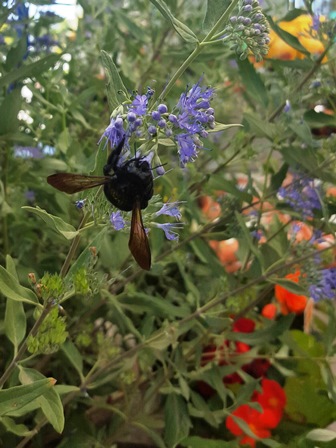Beauty in the Garden–Butterflies and Other Pollinators
I enjoyed studying botany and zoology in school, but never felt attracted to the study of butterflies, bees, beetles, and bugs with any kind of intensity. I regret that. Not only because some of these pollinators are beautiful, but many are also beneficial to gardens and orchards.
As a beekeeper, it’s my job to notice moths, hive beetles, and other flying and crawling insects. Though some are beautiful and beneficial, others can harm my honeybee hives. That’s why when walking around my garden, I pay attention to all sorts of creatures–whether winged or not.
I do love to see butterflies and Lady Beetles (also known as ladybugs, a beneficial garden insect) amid my flowers, bushes, and trees. Today, I spotted a lovely winged creature with black-and-white patterned wings and a blue body.
It stood out against the green leaves of plants in my bee garden and waited for me to run inside the house to get my cell phone camera.
I wonder if anyone can correctly identify this blue-body, black-and-white winged flier for me. Could this be an Arrowhead Blue butterfly? These, I know, are found in Northern California and the Sierras.
Another pollinator that “posed” for me earlier this year is the longhorn bee. It’s about the size of a bumble bee. Some of these fliers are so lovely, I could see spending hours taking pictures.
But chores and all the other farmette tasks take priority over photography. Still, I hope the pictures are clear enough for someone to identify the species when I can’t.
* * *
NEWLY RELEASED–The Murder of a Queen Bee (Kensington Publishing, NY–Sept. 2016).
Discover recipes, farming tips, and sayings as well as sort out a charming whodunnit. Click on the link under the picture.
See, http://tinyurl.com/h4kou4g
See, http://tinyurl.com/hxy3s8q
This debut novel launched the Henny Penny Farmette series of mysteries and sold out its first press run. It’s now available in mass market paperback and other formats.
Moles and More
Fresh mounds of dirt and surface runways have newly populated the rear of the Henny Penny Farmette. I recognize the dirt mounds as telltale signs of the presence of either moles, gophers, or voles.
Since the mounds are small and shaped like volcanoes with ridges on the soil surface, my best guess is that my night visitors are moles–mammals that live underground and create a vast network of tunnels.
Of the three, moles are actually the more preferable since they do not go after plants and bulbs. As insectivores, they eat earthworms and grubs. If you have a flower beds and a lawn, that’s a perfect place for them to find food . . . and they need a lot. By some estimates, they need to eat their body weight daily.
There are ways to detect which little creature you have in your lawn. Moles leave fresh dirt mounds piled like volcanoes. Moles leave subterranean pathways that pop up the soil to look like ridges.
Voles leave no mounds. Pocket gophers leave a horseshoe-shaped mounds of dirt.
Which brings me back to the much maligned mole. Whereas voles are voracious root eaters, moles actually can be beneficial to a garden, eating worms, bugs, and grubs but they don’t eat plants or bulbs. They will starve if fed a diet of only plants. See, http://www.ipm.ucdavis.edu/PMG/PESTNOTES/pn74115.html
Their shallow tunnels aerate the garden soil. And if you find the eruptions unsightly, you simply have to tamp down the raised areas. Scientists have studied methods of getting rid of moles and say none of the home remedies (castor oil, shattered glass, chewing gum, etc.) really works. That’s not to say they can’t be banished; it’s just difficult to find a humane way to do it.
If we gardeners can’t get rid of them humanely, perhaps we could just learn to live with them. Another option is to attract barn owls to your property, since they love dining on moles, gophers, rats, mice, and other rodents. If you build a barn owl nest, they might take up residence. Mother Nature’s eco-control is always best. See, ftp://ftp-fc.sc.egov.usda.gov/CA/news/Publications/wild_habitat/owl_nest.pdf
 Facebook
Facebook Goodreads
Goodreads LinkedIn
LinkedIn Meera Lester
Meera Lester Twitter
Twitter








